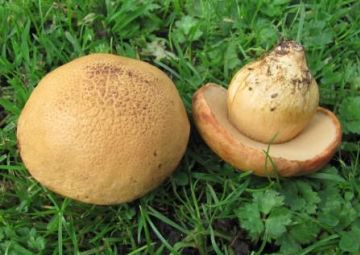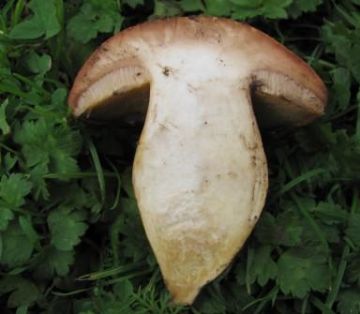Thursday September 30th : Two examples of the scarce bolete, Xerocomus moravicus, were found growing in grass, within the shadow of a large oak, on Fryerning Green this morning. Although scarce it seems to be relatively easy to identify (ho! ho! ho!) compared with many in this group. Cap colour is notoriously unreliable in Xerocomus but the sienna or tawny coloured pileus, which minutely cracks with age and has the texture of suede leather, does seem to be characteristic of this species. The pores are described as lemon yellow by Alan Hills (Field Mycology Voll. 9, issue 3, July 2008) but as pale cream, then yellowish in Funga Nordica (2008), the latter more closely resembling these examples. Again, Alan describes the context (cut flesh) as off-white, unchanging or gradually pale yellow, but unlike Funga Nordica does not mention the brown discolouration beneath the cap cuticle, apparent on the photograph, below. On these examples the flesh turned pale yellow in the base of the stipe but not elsewhere; although it had faded to brownish by the time these shots were taken. FN also states that the stem is sometimes lageniform- fusiform, which means swollen in the middle, tapering at both ends in peasant speak. This too is clearly seen on the photos, although it should be born in mind that these specimens were not fully grown. Microscopically, the terminal hyphae in the pileipellis (cap cuticle) lack incrustations, which appeared to be the case in this instance when examined using Congo Red. It is not an easy feature to observe (or not observe) though!
The BMI database lists two records for Essex, one from Maldon Woods, Colchester in 1980 and the second in Epping Forest, found by Geoffrey Kibby in 1996. The latter is included in Tony Boniface's article on Bolete in the the EN No.19 (2001-02). The photo on Plate 13 of that issue is of the 1996 specimens, taken by Geoffrey, and they closely match my own photos, above. Thus, this record would appear to be the third for the County.




















